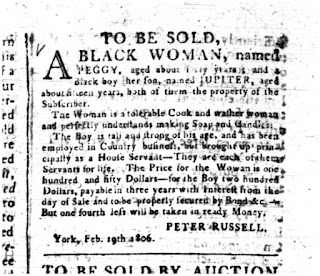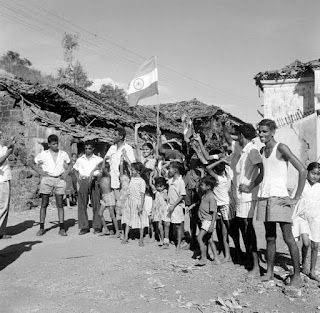As
I have stated before, my relationship
with Goa and time spent interacting with and observing the Goans has made me
rethink and reinterpret my identity as a Canadian and what Canada is.
Over the
years, I have become progressively disenchanted with any display of
nationalism. During childhood, we are all made to learn the words to our
respective national anthem and sing it on cue, and participate in rituals
connected to holidays intended for patriotic celebration. Growing up in Canada,
we had to stand for the national anthem (O
Canada) in school every morning. As a music student, I and my fellow
concert band-mates were also made to play O
Canada for the school on many occasions. One Remembrance Day, in secondary
school, God Save the Queen was added
to the set list, effectively forcing us to pledge allegiance not only to the
idea of Canada but also to the monarchy that continues to enjoy the status of
our country’s official ruling power. And this is something that our government
asks of new Canadians. Yet some are availing of their legal right to
disavow
their oath to the Queen and her descendants.
The
monarchy is becoming increasingly irrelevant to us. And this is where I see
hope for this country. While we have just begun to take steps toward finally acknowledging the genocide and other heinous abuses
committed against the Indigenous peoples of what we call Canada, we have a very
long way to go.
So much is not talked about in this country. For example, we have yet to truly acknowledge that slavery existed in
Canada.
But perhaps as more people immigrate to this country from every part of
the world, we can overcome the deeply racist conception of what it means to be
Canadian and welcome deeper political participation from people from various
backgrounds.
Some
will undoubtedly argue that we are already doing this, as the current Liberal Cabinet has two Indigenous
Canadians, an Afghan Canadian, and four Indo-Canadians. When the Cabinet was
formed in 2015, many Canadians agreed with the Prime Minister’s assertion that
he had chosen a Cabinet that “looks like
Canada”.
However, some Canadians, such as myself, were crying foul. Most glaringly,
there was not even one Black Canadian in the Cabinet. Numerous articles were
written on the subject (see, e.g., Rachel Décoste’s
article)
and debates were had on social media. These debates were intriguing in their
inconsistent logic. The Prime Minister had announced much before that his
Cabinet would comprise 50% men and 50% women. Not surprisingly, this prompted outcries
in print and television media that Trudeau was going to tamper with the
meritocracy!
Then when the induction occurred and the public saw the credentials of the
Cabinet Ministers, this rhetoric dissipated. But when those of us who saw
something was amiss with the representativeness of the Cabinet spoke out, we were accused of wanting to interfere
with the meritocracy! Some lazily argued that perhaps there just weren’t enough
Black, Asian, Arab, North African, Iranian, etc. Canadians in the Liberal
caucus for the Prime Minister to choose from. But a quick glance at the list of
elected Liberal MPs was all it took
to refute this argument. Further, as I pointed out then, all four Cabinet
Ministers of Indian ancestry are members of Canada’s Punjabi Sikh community; therefore,
they do not even reflect the diversity of Indo-Canadians.
Indeed,
I still maintain that the Cabinet reflects an ignorance (perhaps even a racist
notion) of what diversity means. This is not to say that the Cabinet Ministers
are unqualified for their positions; on the contrary. The problem in relation
to the discussion surrounding the Cabinet was all the self-congratulatory
back-slapping of the Liberal Party.
They boasted that this was the most diverse
Cabinet Canada had ever seen, when in fact, as Rachel Décoste pointed out, the
former Conservative Cabinet had actually set the bar for representing Canada’s multicultural
character.
Perhaps it was that Canadians were paying closer attention, given
Trudeau’s promise of change. Or perhaps it was that Trudeau’s team simply looked ‘more different’ to some people. Whatever the reason, such felicitation over
the composition of the Cabinet suggests that any person of colour can speak for
all people of colour—thinking that effectively others everyone who isn’t white.
Celebrating
the nomination of four Indo-Canadians to Cabinet whose ancestors can be traced
to the same part of the Indian subcontinent is interesting to me because it suggests
that there is some monolithic Indian identity. But as anyone who has ever lived
in South Asia knows, there is tremendous diversity among its inhabitants
(infinite languages and dialects, various religions and traditions within the
same religion, varying dietary habits, etc.). Such thinking is evident here
when someone born in Canada meets a Goan Catholic, for example, and is puzzled
as to why he or she has a Portuguese-sounding name. After all, this contradicts
the image of Indianness that has been framed in Canada (Aren’t all Indians either Hindu or Sikh and have surnames like Patel or
Singh?).
I
see parallels in this idea of a uniform Indianness when I’m in Goa too. It’s no
secret that there is heavy nationalism at play throughout India right now.
India is a beautiful and fascinating country; no two places are really alike.
This is both where the country’s strength lies and where it poses a challenge
to those who want to concisely define this landmass and the people who live on
it—which invariably takes the shape of a North Indian
identity.
Besides physically inhabiting the territory called ‘India’, what do the
citizens of India have in common? One can ask the same question about Canada.
Owing to its history, Canada seems to be in perpetual need of defining itself.
Similarly, since its annexation to India in 1961, Goa has been under pressure
to define itself in connection with the mainland. Undoubtedly, this pressure to self-define would
date back even further, but let’s deal with the present day for now.
The
complexities of Goa are such that I feel I’m still unravelling and only
starting to understand them—a decade-and-a-half after my first visit. While the
perspectives of the Goans are numerous, in everyday conversation about what is
happening and what the future should bring, the following three voices seem to ring
the clearest: (1) those who are caught up in nostalgia, (2) those who have a
strong sense of Indian nationalism, and (3) well-meaning types who lament the
loss of the natural environment and the character of the place they remember,
but who aren’t necessarily prepared to disrupt the status quo to stop this
process. I believe that none of these three perspectives is helpful. They all
overlook the greater problem that an external ideology is being imposed on Goa.
Indeed, I would argue that one of the issues holding Goa back is the desire for
a saviour—more specifically, an external saviour.
I see it in all three of the aforementioned
perspectives (e.g., the Portuguese vs. Congress–BJP vs. Arvind Kejriwal and a
Delhi-centred AAP). I rarely hear calls for Goans to unite and shape the future
of the state together. This may be the result of a long history of division
among the people (for a clear, succinct explanation of these divisions, see
e.g. Raghuraman S. Trichur’s book Refiguring
Goa: From Trading Post to Tourism Destination). Such a lack of unity can do
nothing but enable the ongoing destruction of the environment and physical and psychological
colonization.
I
had a heated discussion with an AAP volunteer in May, when we were both in
attendance at the same gathering in Panjim. She was singing Arvind Kejriwal’s
praises while criticizing the BJP’s Hindu nationalist ideology. I opined that
the lack of a strong local voice in AAP’s Goa wing was a problem, especially
since Kejriwal had recently addressed the crowd at the AAP rally in Panjim in
Hindi, using overtly Hindu nationalist language, including the phrase ‘Bharat mata ki jai’ (‘Victory to Mother
India’). Whether you do or do not take issue with this slogan, it is
significant for a politician from Delhi to come to Goa and say such a thing. Some
others mentioned that he hadn’t spoken in Konkani; this, I think, would be
unreasonable to expect, but it would not have been difficult for him to at
least greet the crowd in English. He chose
not to.
I asked her what reassurance she had that Kejriwal doesn’t espouse the
Hindutva ideology himself. The exuberant AAP volunteer told me that she just
knew in her heart that Kejriwal was trustworthy. She went on to ask me if I’m
Goan. When I told her that I am not, she lost interest in continuing the
conversation and walked away.
I’m
aware of the strange position I’m in as an outsider urging the Goans against
seeking deliverance from an outsider. My position is similar in the context of
my own country, as a white Canadian who is eager for the dismantling of the system
of whiteness that controls everything. In fact, my position as an insider–outsider
in Goa has not only helped me understand my privilege in Canada and as a
Canadian in the world but also the role that I can play in working towards
deconstructing this system as well as in challenging Canadians’ rigid ideas
about Indianness. So, similarly, my purpose in writing about Goa is in shining
a light on things as I see them from this particular position, without claiming
to have the answers.
Identity
is not just a project of the individual; belonging is also integral to this
formation. The myth of the uninhabited land is crucial to colonization; the
erasure of the locals and their identity allows the colonizer to use that land as he
sees fit. Thus, when we operate solely as individuals, this disconnects us
from each other and makes erasure possible. This has become clear to
me during my time in Goa, and I see similar workings in the exclusion of Black
Canadians and many others from power in Canada and from the Canadian identity.
What
does it mean to be Goan? If this question goes unanswered, it will cease to be
relevant, because another identity will be imposed on Goa. And as for Canada, I think many of us will agree that we still have work to do to figure out who we are.

















